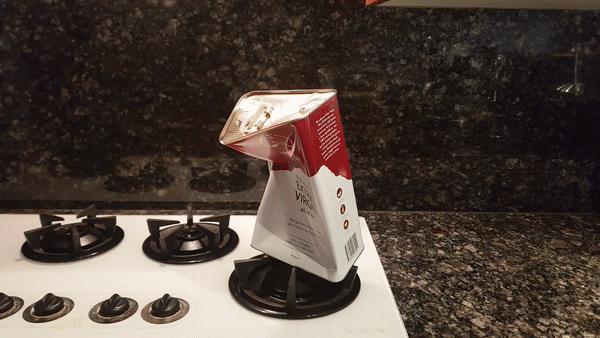What you need:
A metal can which can be sealed, Water, tongs or oven mitts
What to do:
Place a little water in the can (around 50 ml).
- Put the can on the stove until the water boils vigorously.
- Turn off the stove, and put the lid on the can. You might need to remove the can from the stove, or put it in water to cool it off – do this with tongs or oven mitts as the can will be hot.
What happens
When water boils, it becomes a gas, sometimes called vapor water. In contrast to liquid water, gaseous water spreads or expands to occupy the volume of its container.
In this experiment, when the can is open, the water vapor molecules can be exchanged between the can and its surrounding. This also means the pressure inside and outside the can is equal.
When the can is sealed, the water molecules are trapped inside.
Once we stop the heating and seal the can with the now trapped water vapour molecules, the temperature inside the can starts to decrease. As the temperature decreases (cools), part of the water vapor will condense (become liquid) and take up less space in the can. As this happens, the pressure inside the can is also decreasing. The pressure outside the can is now more than the inside and this difference will increase as the water and air in the can keep cooling down.
At some point the difference in pressure will be too much and the greater pressure outside the can will lead to the crushing of the can.
If the rigidity of the container walls is increased, it is more difficult to crush the can. Think about the design specifications for a submarine or spacecraft – see below.
A bit more
A similar but opposite effect occurs when air is inflated in a balloon. In that case, the pressure inside the balloon is larger than outside which leads to the expansion of the balloon. Above a critical pressure, the balloon can even explode!
Now put an inflated balloon in the fridge and observe what happens.
A balloon in the fridge should become smaller and have a lower pressure than a hot balloon. As air cools, the air molecules slow down and get closer together (shrinking balloon). As the air warms up, the air molecules get more active and fly around more, collide with each other more and generate a higher pressure inside the balloon (expanding balloon).
For more balloon fun check out the FLEET’s Balloon Rockets activity
Avoiding the crush and explosions
Understanding how pressure works in this way is important especially when we design things such as submarines or spacecraft. For example, our Australian Collins Class submarines have a maximum diving depth of 180 metres. At sea level, we say there is 1 atmosphere of pressure. That pressure increases about one atmosphere for every 10 meters of water depth (ie note the pain in your ears when you dive to the bottom of a pool. That is the increasing water pressure squishing your ear canals – Eustachian tubes). Therefore, the Australian submarines need to be able to withstand 18 atmospheres of pressure, which is a lot (about 260 psi). Unmanned research vehicles go way deeper than submarines.
Spacecraft experience the opposite. As they head into space they experience reduced pressure until they reach the vacuum of space where there is essentially zero pressure. Once in space, the pressure inside a spacecraft is higher than outside. The pressure inside the spacecraft is required to keep the astronauts alive. If there is a breach in the hull of the spacecraft, air will rush out reducing the pressure until it reaches the same as outside the spacecraft (ie zero). We can’t survive in a vacuum. For a start, all the water in our body will boil because the boiling temperature of liquids decreases with decreasing pressure. NASA has a great resource/lesson plans that explains all this.
By Olivier Bleu (FLEET Research Fellow)
Back to Home Science activities.



